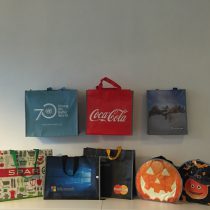Fast Forward - May 2017
Lighting The Way
Five Minutes With Olivier Van Migem and Michael Reisbaum, Reflective Shopper

Michael Reisbaum

Olivier Van Migem
Four years ago, in a dark parking lot, Olivier Van Migem ran into someone leaving a supermarket—with his car. The pedestrian was unharmed, thankfully, and Van Migem left the incident with a new idea. “I strongly believe in destiny,” says Van Migem, who at the time was manufacturing reusable bags. The encounter inspired him to add reflective trim to those bags for better visibility in dark environments. Thus, the Reflective Shopper was born.
Since entering the promotional products market as a supplier, owner Van Migem and his team have expanded their fully patented offerings from reflective reusable totes to bags with custom designs that can be colored in by the end user, and reflective bags designed for use by children who go trick-or-treating on Halloween.


PPB spoke with Van Migem, who is based in Antwerp, Belgium, and Michael Reisbaum, U.S. director of operations who is based in West Nyack, New York, about bringing reflective shopping bags to the global promotional products industry.
PPB You offered your bags in Europe prior to entering the U.S. market; why?
Van Migem When I visited the production factory in Spain, I learned that there are five different ways trim can be added to the bags. So I secured five different model patents. But in the U.S. it can take 18 to 24 months to secure a patent; now, our patents are recognized in Canada, Mexico, Brazil, Turkey, Australia, India and Russia and South Africa, as well as in the U.S. and Europe. We’re committed to defending our patents, ensuring our distributor partners are fully protected from imitators.
PPB Why did you transition from offering your bags through other suppliers to becoming a supplier yourselves?
Van Migem The bag was not being marketed [as a unique item], and at the end of 2016 I decided I needed to find a solution. In 2017 we started our business in the U.S., launching at The PPAI Expo in Las Vegas. The big difference with us is the way we approach business—acting not as a supplier but as a true partner.
PPB What’s your go-to-market strategy as a partner to your distributors?
Reisbaum We both have the entirety of our experience in the [promotional products] marketplace as distributors. Our product is not an item that can be sold by simply sending someone a catalog; we don’t want to be in some bucket of suppliers who offer a little bit of everything. We want to help communicate its value to our distributor partners, so we are going to help them come up with selling solutions. We ask them, ‘Help us create the best presentation for your client.’
PPB Bags are the second most popular promotional product category in the U.S. How does yours stand out in this crowded segment?
Van Migem We do not sell bags, we sell a concept. Our concept fulfills the values of the biggest companies in the world—sustainability, safety, creativity (coloring edition) and great visibility for brands. Not only are we taking care of the environment, but we are also taking care of the clients. Our concept is not a safety item, but it will increase the visibility in traffic of pedestrians during the darker period of the day. It’s innovative, dynamic and socially responsible. I believe in the reusable tote’s sustainability. People need to understand sustainability—it is being able to use a product as long as possible.
WATER COOLER
Generally Speaking
Knowing a little about a lot can be just as beneficial as being a specialist
You know the phrase ‘Jack of all trades, master of none’? The philosophy of knowing a little about a lot doesn’t always jibe with long-term business success. Mastery of one skill or subject makes one more valuable to employers; experts and thought leaders are highly sought after in sports, academia and industry.
But those of us who tinker, who constantly look for new skills to acquire (if not master) and new subjects to learn, can be just as valuable to the workplace. Imagine if the one thing you did really well, better than your peers, was suddenly automated or phased out. Where would that leave you? Rather than trading one knowledge philosophy for another, consider adopting the T strategy.
The T strategy aligns generalization, or breadth of knowledge, with specialization, or depth of knowledge. To visualize it, plot out the subjects you know fairly well on a horizontal line. From each subject of which you feel you have extensive knowledge, draw a vertical line down.
Looking at your drawing, does it appear that you have extensive knowledge of one subject, or a little knowledge about many subjects? If you are more of a generalist, consider brushing up on just a handful of topics or skill sets. Don’t just learn about something, though—learn how to put it to use. Develop a personal project to apply your newfound knowledge and use the results to build a portfolio.
If specialization has been your mantra for years, consider learning more about a field that’s related to the one you’re an expert in. Look for interactive learning opportunities to apply your new knowledge while you’re still learning; more than just quizzes at the end of a lesson, true interactive learning asks you to apply what you just learned to a real-life (simulated) situation. Once you’ve built a foundation for your new skill, find a way to make it enhance what you’re already great at.
AD-ITIVES
Exalting Enterprise
Shinola campaign celebrates the American worker in series of billboards, murals
In the heart of gritty Detroit, luxury goods maker Shinola is aiming to boost the visibility of what makes America great—its workers.
The company, whose journals are offered in the promotional products industry by Delray Beach, Florida-based supplier The Book Company, launched a series of billboards and murals that tell the story of enterprising people who made opportunities for themselves in their respective communities. Shinola also is running print ads in the Detroit Free Press this month. Chief Marketing Officer Bridget Russo told Crain’s Detroit Business Press in March that the campaign “embodies the American spirit of rolling up our sleeves and getting stuff done.”
This spirit is what Shinola also wants to keep alive in Detroit and in other U.S. locations where it assembles watches, leather goods and bicycles. “The underlying message will always be jobs, workforce development and people who are paving the way either within our four walls or outside of our four walls doing great things in their community to move their community,” Russo added.
SELLING POINT
Problem Solved
Customers want solutions. Which ones do your products provide?
Creating a unique value proposition to position your business above your competitors’ is a universal challenge. But if that value proposition is anchored by a product or service, you’re not hitting the customer’s soft targets. American economist Theodore Levitt once said, “People don’t want to buy a quarter-inch drill. They want a quarter-inch hole.”
Now imagine that you could anticipate your customers’ problems—would you still pitch a product, or would you pitch a solution? How would you develop your approach? Sonja Jepsen, vice president of consultant relations for Fidelity National Information Services, offered these suggestions in Entrepreneur magazine:
1 Treat sales like customer service. You have to know your customers’ needs in order to position what you sell as a unique solution. This requires sales teams to have in-depth knowledge and expertise regarding your product or service. Look at Apple Store employees as an example.
2 Educate the buyer. Customers who learn how your product solves their problem see the product from a new perspective and can more clearly recognize its value.
3 Get everyone on board. Solution selling isn’t just for salespeople. Each department in your company has an integral role in this new approach to building business.
4 Connect sales and marketing. A sales ‘liaison’ can help bridge the knowledge gap between sales and marketing, and it can ensure marketing staff are clear about the sales team’s needs and can develop leads based on desired demographics and communication preferences.
MARKET SHARE
Under The Influence
Up your outreach game with influencer marketing
From superfans to brand ambassadors, the people who love products and the companies that produce them are the new key to successful marketing campaigns. Influencer marketing is where it’s at for 2017, and to use it successfully, you need to know what it is—and what it isn’t.
Influencer marketing hinges on brands finding and inspiring—and in some cases paying—individuals who can extoll the virtues of their product or service to others. YouTube “celebrities” are among the more well-known types of influencers, particularly in the beauty industry. The strongest partner of influencers is social media. Influencer communications almost always have a strong social media component to their evangelism, and they often produce original content around the product or service they’re promoting.
While this may sound like a substitute for traditional word-of-mouth marketing, experts say word-of-mouth marketing is the tool by which key individuals influence their circles—friends and family. And while nearly all influencer marketing includes word-of-mouth marketing characteristics, not all word-of-mouth marketing is driven by influencers.
Influencer marketing shouldn’t be confused with advocate marketing either. The latter relies on incentivizing already loyal customers to continue promoting a brand, whereas influencers don’t necessarily have to be current customers. Additionally, influencers are often paid in the form of compensation or products. If you think you’re ready to pursue influencer marketing as a strategy, concentrate on these points:
1 Identify key brand or product influencers who are related to, or part of, your target audience.
2 Create a marketing campaign directed toward those influencers.
3 Create a secondary marketing campaign for influencers to use in building brand awareness among their audiences.

